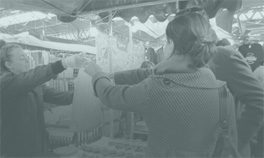Starting at Home: Housing-based Approaches to Financial Stability
Written by Paul Weech, NeighborWorks AmericaHousing plays a central role in the financial stability, or too often the instability, of America’s families and communities. Housing costs are typically the single largest expense in a family’s budget and, especially for low-income families, often a significant financial burden. The massive job losses and high levels of underemployment during the Great Recession exacerbated the national housing affordability crisis. Worst case housing needs — defined as very low-income renters paying more than 50 percent of their income for rent, living in substandard housing, or both — have risen to more than 7.7 million households, or 6.7 percent of all households, in 2013.1 The recession caused many homeowners to lose their homes; others watched their equity disappear and ended up “underwater,” owing more than their houses were worth.
Too many Americans are living at the edge, where life’s emergencies — the loss of a job, break up of a marriage, major health event, or death of a loved one — can mean financial disaster. The 2015 NeighborWorks survey on financial capability found that 34 percent of adults do not have any emergency savings.2 This figure increases to 50 percent for African Americans and 42 percent for Hispanics. Studies show that it will take an average of 31 weeks for someone who is unemployed to get a new job, a timeframe that requires more than two times the average amount in reported emergency savings. Across the country, high housing costs remain a barrier to savings.
Housing stability itself is a predicate to financial stability. For homeless and very low-income families and individuals, permanent supportive housing, “housing first” models, and subsidized housing provide stable housing situations and provide families and individuals room to work on other financial needs. For many in communities with rapidly rising rents, an amortizing, fixed-rate mortgage option is another form of financial stability that makes budgeting for other life needs relatively easier. For low-income and minority communities, home equity remains an important source of household wealth, and the promise of sustainable homeownership remains an important path to savings and intergenerational wealth transfer.
Nationally, housing markets are showing signs of improvement, but the recovery has been uneven across communities — millions remain underwater on their mortgages and millions more are living in neighborhoods ravaged by blight and abandoned properties. The lack of affordability remains a major challenge in many communities and further harms families struggling to achieve financial well-being.
The nation needs to redouble its efforts to lower housing costs and increase earnings to help lower-income families both afford decent housing and have sufficient resources to meet other basic needs. The nonprofit housing and community development organizations in the NeighborWorks network focus on stabilizing neighborhoods and helping communities and families recover.
Rebuilding Resident Financial Capability
Housing and community development nonprofits are combating housing and financial instability by offering an array of services that promote stable housing and stable household budgets. The central services available throughout the NeighborWorks network are homebuyer education, housing counseling, financial capability and coaching services, access to affordable mortgage products, and post-purchase assistance. Homebuyer education helps families prepare for the complexities of the home buying process, from working with a REALTOR© and selecting a lender and the right mortgage product, to analyzing the household budget and understanding the costs of homeownership, including those that are unforeseen. Sometimes the right answer is that now is not a good time to purchase a home.
The housing counselor plays a particularly important role as a trusted advisor — someone who can provide guidance on the paperwork and loan terms on the front end, and can also step in if financial issues arise at any time during the homeownership experience. Although buying an affordable home in the right place with the right financing is not a guarantee of financial success, it remains a proven strategy for wealth-building for a large number of families, especially with the kind of support NeighborWorks organizations provide.
Our network has also expanded the availability of new tools to support family economic stability through a national initiative focused on training nonprofit professionals as financial coaches. The program has shown great results: 57 percent of participants who started with no savings were able to establish a savings habit following coaching, and 48 percent of those who were already saving increased the amount they regularly set aside. The programs vary by area and are often targeted to meet the needs of specific populations. For example, the Her Family program offered by the Primavera Foundation of Tucson, Arizona, helps single mothers and their daughters learn about building a healthy financial future. Mothers work one-on-one with a financial coach and focus on the family budget. Daughters attend peer-led classes where they learn to participate in family budgeting and have the opportunity to open their first savings account.
NeighborWorks supports homeownership as a HUD-approved housing counseling intermediary and through a network of 100 Homeownership Centers around the country. The centers provide a one-stop shop for people seeking to buy a home. Recognizing that the lack of savings for down payments is a significant barrier to homeownership, NeighborWorks administers a down payment assistance program called LIFT that has expanded opportunities for thousands of homebuyers across the country.
By shoring up property values in a community, neighborhood stabilization programs are another strategy for increasing household financial stability. New, more sophisticated approaches to community revitalization are emerging to help stabilize neighborhoods that are at the tipping point between recovery and falling into further disinvestment. These include strategic investments, such as fixing up multiple homes at the same time or demolishing vacant properties, combined with marketing and rebranding efforts to help communities move beyond stabilization and build positive momentum.
For example, despite a variety of amenities, the community of Roseburg, Oregon is often associated with crime and disinvestment. To counter these perceptions, NeighborWorks Umpqua and its partners held a branding design session as part of the Neighborhood Marketing Program, a national effort to create strong neighborhood brands and rebuild market demand. More than 100 community members convened at a local church to share what they liked most about the downtown area. Based on their ideas, the group selected a new name for the district, the Heart of Roseburg, and created a logo. They developed a Facebook page and produced videos in which residents shared personal stories. These activities hold the promise of stabilizing home values, stimulating investment, and attracting more visitors to the Heart of Roseburg.
Advancing the Nonprofit Sector’s Role in Financial Stability: Policy and Practice
In the wake of the financial crisis, policy makers and practitioners alike must apply the lessons learned to advance policy and practice. First and foremost, we must focus attention on the sustainability and impact of the nonprofit housing and community development delivery system on which we rely to provide services to people and communities. For example, the sector and the communities we serve will benefit from the increased use of social enterprise models, which apply more business-like principles to achieving the organizations’ missions. Social enterprise approaches include charging fees for services; better using and leveraging private capital; taking advantage of economies of scale; adopting new branding and marketing techniques; diversifying revenue sources; and improving operational efficiencies and managing costs. Meanwhile, as we seek to rebuild the path to homeownership for those families who need time to accrue savings and repair credit, policymakers should consider how to expand the availability of hybrid tenure models, such as lease-to-own, community land banking, and shared-equity models — the success of which often depends on the work of a strong nonprofit.
We also must recognize the importance of community stability to family financial stability. To this end, we must continue to promote the development of the “community quarterback” model. The quarterback is the convening organization that articulates the vision, marshals the funding sources, and aligns the work of partners required to execute successful community development.3 Strong nonprofit institutions that play this central role of coordinating multiple players are critical for restoring low-income neighborhoods. Beyond Housing, a network member working in suburban St. Louis exemplifies the power of this role. Beyond Housing has taken the lead in attracting new development to Pagedale, Missouri, including the community’s first grocery store and bank branch. Beyond Housing has also worked to organize the mayors of 24 municipalities to provide support and services designed to help the school district regain its accreditation. Good schools are critical to stabilizing property values and building future financial opportunities for kids.
Finally, we need to pursue strategies to make financial advisors and coaches more readily accessible and affordable to low-income households. Accessibility will improve as we work to embed access to homebuyer education and counseling into the housing finance system. The costs of these services can be shared among all the beneficiaries of a system that produces ownership-ready homebuyers and better performing mortgages. But more is needed. One way to expand the availability of these services is to build strong nonprofits that can cover the costs of financial coaching in the context of other sustainable social enterprise activities. Homewise, a NeighborWorks affiliate in New Mexico, has been at the forefront of this effort. Homewise’s vertically integrated business model enables it to provide assistance to potential homebuyers from initial counseling through finding a home, securing a mortgage, and post-purchase guidance. They do so using revenue from the organization’s real estate brokerage and mortgage banking.
The challenge of restoring stability to troubled families and communities is large, but we have the tools to make it happen. NeighborWorks affiliates across the country are helping to lead the way.
- Barry Steffen et al., “Worst Case Housing Needs: 2015 Report to Congress” (Washington DC: U.S. Department of Housing and Urban Development, April 2015).
- NeighborWorks America, Consumer Finance Survey Results.
- See, for example, “Routinizing the Extraordinary,” by David Erickson, Ian Galloway, and Naomi Cytron in Investing in What Works for America’s Communities, edited by Nancy Andrews et al. (San Francisco: Federal Reserve Bank of San Francisco and the Low Income Investment Fund, 2012), p. 377.




